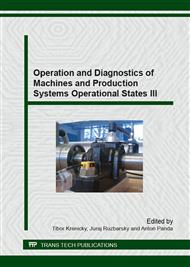[1]
S. Fabian, Ľ. Straka, Operation of production systems, Edition of scientific literature, TU Košice, Prešov, (2008).
Google Scholar
[2]
T. Krenický, Non-contact Study of Surfaces Created Using the AWJ Technology, Manufacturing Technology 15/1 (2015) 61-64.
DOI: 10.21062/ujep/x.2015/a/1213-2489/mt/15/1/61
Google Scholar
[3]
J. Jurko, A. Panda, Study of the tool life and the tool wear mechanisms in the production of holes in stainless steel, Applied Mechanics and Materials 459 (2014) 424-427.
DOI: 10.4028/www.scientific.net/amm.459.424
Google Scholar
[4]
T. Krenický, Implementation of Virtual Instrumentation for Machinery Monitoring, in: Scientific Papers: Operation and Diagnostics of Machines and Production Systems Operational States: Vol. 4, RAM-Verlag, Lüdenscheid, 2011, pp.5-8.
Google Scholar
[5]
R. Kreheľ, Ľ. Straka, T. Krenický, Diagnostics of production systems operation based on thermal processes evaluation, Applied Mechanics and Materials 308 (2013) 121-126.
DOI: 10.4028/www.scientific.net/amm.308.121
Google Scholar
[6]
I. Čorný, M. Fedák, M. Rimár, Chilled Ceiling Adaptive Control with Application of Parameters Gained from the Chilled Ceiling System Proposal Algorithm, Applied Mechanics and Materials 616 (2014) 317-324.
DOI: 10.4028/www.scientific.net/amm.616.317
Google Scholar
[7]
I. Maňková, Progressive Technologies, Technical University of Kosice, Faculty of Mechanical Engineering, (2000).
Google Scholar
[8]
P. Malega, Comparison of management bottlenecks systems in production process, Transfer innovation 26 (2013) 152-157.
Google Scholar
[9]
J. Mihalčová, Test methods validation in the tribotechnical diagnosis, Engineering Extra 5 (2012) 48/1-4.
Google Scholar
[10]
M. Neslušan et. al., Experimental methods in splinter machining, EDIS ŽU, Žilina, (2007).
Google Scholar
[11]
A. Panda, M. Prislupčák, I. Pandová, Progressive technology diagnostic and factors affecting to machinability, Applied Mechanics and Materials 616 (2014) 183-190.
DOI: 10.4028/www.scientific.net/amm.616.183
Google Scholar
[12]
A. Panda, J. Duplák, Comparison of theory and practice in analytical expression of cutting tools durability for potential use at manufacturing of bearings, Applied Mechanics and Materials 616 (2014) 300-307.
DOI: 10.4028/www.scientific.net/amm.616.300
Google Scholar
[13]
J. Ružbarský, J. Paško, Š. Gašpár, Techniques of Die Casting, RAM-Verlag, Ludenscheid, (2014).
Google Scholar
[14]
J. Ružbarský, Dynamics of core taking out at die casting, Applied Mechanics and Materials 616 (2014) 244-251.
DOI: 10.4028/www.scientific.net/amm.616.244
Google Scholar
[15]
Ľ. Straka, Analysis of Wire-Cut Electrical Discharge Machined Surface, LAP Lambert Academic Publishing, Germany, (2014).
Google Scholar
[16]
Ľ. Straka, Čorný, I., Kreheľ, R., Evaluation of capability of measuring device on the basis of diagnostics, Applied Mechanics and Materials 308 (2013) 69-74.
DOI: 10.4028/www.scientific.net/amm.308.69
Google Scholar
[17]
P. Stephen, P. S. Radzevich, R. Kreheľ, Application priority mathematical model of operating parameters in advanced manufacturing technology, The International Journal of Advanced Manufacturing Technology 56/2 (2011) 835-840.
DOI: 10.1007/s00170-011-3221-x
Google Scholar
[18]
Ľ. Straka, I. Čorný, Heat Treating of Chrome Tool Steel before Electroerosion Cutting With Brass Electrode, Acta Metallurgica Slovaca 15/3 (2009) 180–186.
Google Scholar
[19]
Ľ. Straka, V. Simkulet, Wire Tool Electrode Wear in the Electrical Discharge Process, in: Operation and Diagnostics of Machines and Production Systems Operational States, RAM–Verlag, Germany, 2011, pp.35-41.
Google Scholar
[20]
Ľ. Straka, I. Čorný, J. Mižáková, Analysis of heat-affected zone depth of sample surface at electrical discharge machining with brass wire electrode, Strojarstvo: Journal for Theory and Application in Mechanical Engineering 51/6 (2009) 633-640.
Google Scholar
[21]
Ľ. Straka, S. Fabian, S. Hloch, The modeling and simulation of quality in process EDM cutting with wire electrode, in: Proc. of the 5th Int. Conf. DAAAM Baltic: Industrial engineering, University of Technology Tallinn, Estonia, 2006, pp.167-170.
Google Scholar
[22]
T. Krenický, Multi-parametric monitoring using virtual instruments, in: Proc. of SHMD´2014, 11th International Symposium of Croatian Metallurgical Society, Zagreb, Croatian Metallurgical Society, 2014, Vol. 53, No. 3, p.426.
Google Scholar
[23]
A. Vagaská, The application of neural networks to control technological process, in: Proc. of the 2013 Int. Conf. on Applied Mathematics and Computational Methods, Recent Advances in Applied Mathematics and Computational Methods, Italy, 2013, pp.179-186.
Google Scholar
[24]
J. Žitňanský, J. Žarnovský, J. Ružbarský, Analysis of physical effects in cutting machining, Advanced Materials Research 801 (2013) 51-59.
DOI: 10.4028/www.scientific.net/amr.801.51
Google Scholar


